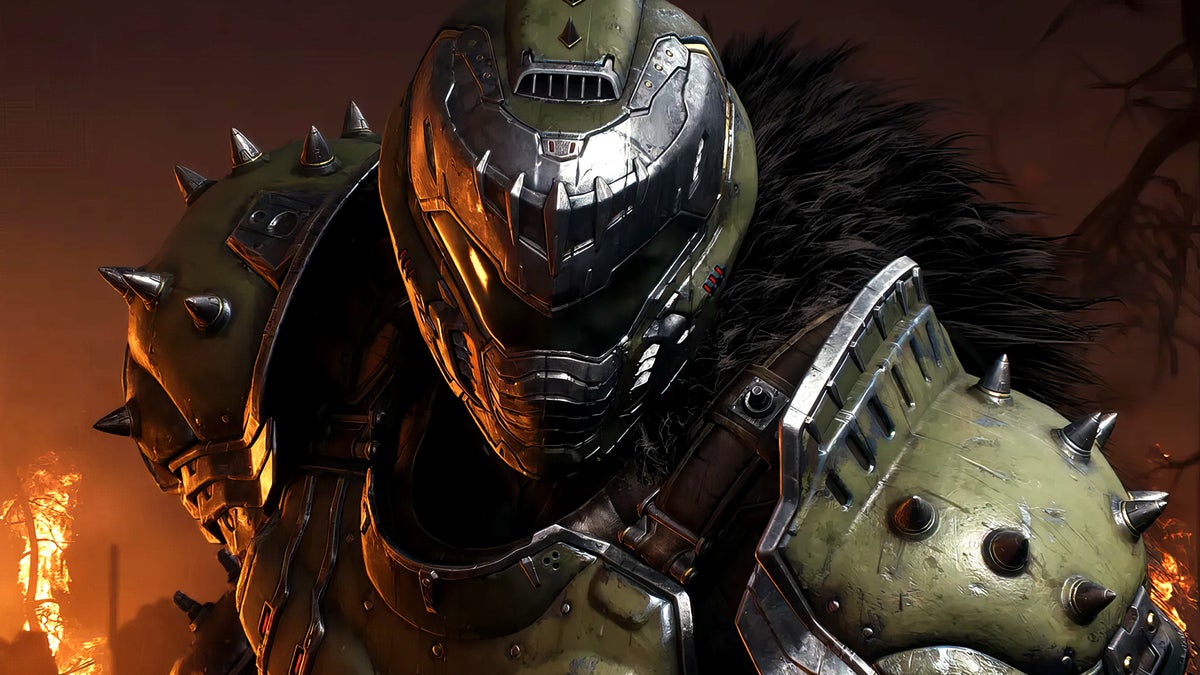
Doom: The Dark Ages is our first look at the latest version of the legendary id Tech engine, as the series seemingly moves from the relatively constrained battlescapes and glory kills of Doom (2016) and Doom Eternal to something on an altogether grander scale for current-gen consoles and PC only. While the trailer contains less than two minutes of actual gameplay footage, there’s still plenty to glean about The Dark Ages and its tech from what id has revealed thus far.
The first thing I noticed in the trailer was something I didn’t expect for a Doom game: volumetric clouds. They’re featured prominently in many shots of the trailer, with the most obvious shots being the intro shot of the burning citadel floating in the sky. Here, the clouds wreathing the structure show clear evidence of local self-shadowing, lighting from the sun and light transmission, visible on the clouds’ fringed edges.
Later on, as the Doom Slayer is shot down planet-side, the clouds part around him – though it’s likely that this is a VDB animation playback of some sort, rather than a physicalised volumetric simulation given the performance implications. Nonetheless, you can actually spot volumetric clouds throughout the trailer, often above mountains in the distance, and they sometimes seem to show evidence of movement and evolution – interesting stuff.
The trailer also gives a good overview of the scale of the environments, which appear to possess little obvious gatekeeping and a much wider area of play. If that’s indeed the case, then volumetric clouds are a sensible choice, as the art for the sky can be iterated on more easily versus a static skybox. These clouds also help to maintain proper parallax, perspective and visual quality in games where you can fly. This isn’t something available in the previous two modern Dooms, but the trailer shows a rideable dragon that makes good use of that cloud tech.
Beyond the cloud implications, having a large play area means that level of detail (LOD) transitions, where assets are swapped out for higher quality versions as they come closer and therefore are larger on-screen, are of critical importance. These LOD transitions felt natural thoughout, with only a handful visible by eye despite the fast camera movement.
Objects also look great close up, at least based on the few items that we saw this way in the trailer. Doom Eternal heavily increased the amount of visible geometry on-screen versus Doom (2016), and it looks like there’s a similar trend in The Dark Ages. The super shotgun, for example, is extremely round – nary a polygon edge in sight! – and the close-ups we see of the Doom Slayer show a lot of detail that is realised with real geometry, such as his spiked mail fist. Textures also seem universally high-res on close inspection, with one of my favourite details being the animated rain texture seen in the intro. This is subtle, but it looks fantastic.
One thing I struggled to find was clear visual evidence of ray tracing. Doom Eternal added in RT reflections in a patch for PC and the high-end consoles, so I expect to see the same again here, but the environments and lighting choices aren’t as fitting. Most metals are very worn, making RT reflections more subtle, and when glossier surfaces did appear on the screen, they exhibited screen-space artefacts. Doom Eternal did mix screenspace reflections with RT reflections, which is what I imagine is what I’m seeing here, but as of now it remains unconfirmed.
The last thing I noticed in the trailer was just how real it was; it didn’t look faked in any sense of the word. I’d say that we’re unquestionably looking at something rendered in real time based on the performance fluctuations throughout the trailer. Breaking out the frame-rate analysis tools, we can spot drops into the 30s when explosions are triggered, and there are dropped and duplicate frames elsewhere too. That suggests genuine gameplay footage that’s still work-in-progress. Given id’s track record, I’d still expect a smooth (if not perfectly locked) 60fps on current-gen machines.
As a Doom fan, the trailer is massively exciting, and it came out with incredible swagger by showcasing new gameplay, weapons and enemies, all timed to a banger of a backing track. It’ll be fascinating to see what else is revealed about the game’s tech on the run-up to launch.
